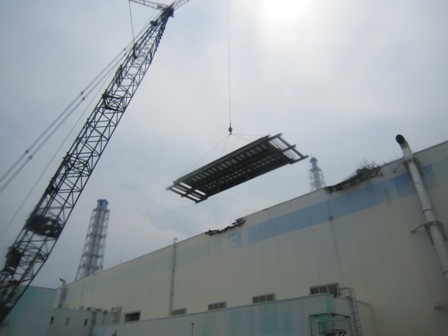Tepco prepares for typhoon
19 July 2011
As a strong typhoon approaches Japan, a temporary cover has been constructed for the damaged roof of one the turbine buildings at the Fukushima Daiichi nuclear power plant. Meanwhile, stable cooling of the reactors and used fuel pools has been achieved.
 |
A steel sheet is raised onto the roof of the third turbine building
(Image: Tepco) |
Tokyo Electric Power Company (Tepco) said that a large hole in the roof of the turbine building of unit 3 was made by falling debris after a hydrogen explosion in a neighbouring reactor building in March.
With Typhoon Ma-on approaching southwestern Japan, the company has taken precautions against high winds and heavy rains by installing steel plates and beams to cover the 14-metre by 11-metre hole in the turbine hall's roof. Three 30-centimetre thick steel plates, each measuring 16 metres by 5 metres and weighing 6.5 tonnes, have been installed on top of the building to prevent too much water entering and accumulating in the basement, which is already home to hundreds of cubic metres of contaminated water.
When releasing its roadmap for restoration works at Fukushima, released in April, Tepco said that it planned to install covers over the damaged reactor buildings to prevent the release of radioactive materials. These could be replaced or augmented later with more permanent structures over the reactors, it said. Preparations for the first temporary reactor building cover have already started for unit 1 and the main structure is being tested off-site.
Stable cooling
In a progress report on its restoration works, Tepco said that the damaged reactors had been brought to a state of 'stable cooling' according to schedule. The establishment of a cooling system of the reactors has led to a reduction in the amount of steam being generated and, in turn, a steady decline in the amount of radioactive materials being released.
Tepco said that the temperature at the bottom of the reactor pressure vessels of units 1, 2 and 3, "does not show an upward trend" and the heat being generated in the reactors is being steadily removed. They remain, however, above the 100ºC benchmark that defines cold shutdown. The goal for reaching that level is January 2012.
With the introduction of a water processing facility to recondition water for re-injection to the reactors, the total amount of contaminated basement water is not increasing. The risk of further hydrogen explosions has been avoided by injecting nitrogen into their primary containment vessels.
Stable cooling of the used fuel pools of units 2 and 3 has been achieved through the restoration of the normal cooling systems and the installation of additional heat exchangers. At unit 4 the temperature is high at over 80ºC, but an external water injection system has maintained water levels and adequate cooling. At unit 1 the temperature is not known, but water injection using normal lines is taking place and additional heat exchangers are planned to begin work in the beginning of next month.
Researched and written
by World Nuclear News